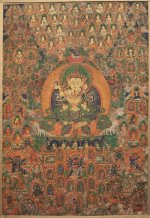The Barawa Kagyu ('ba' ra ba bka' brgyud) was established in the fourteenth century by Gyeltsen Pelzang from Baradrak in Shang. Gyeltsen Pelzang also founded the first monastic complex of this tradition there, Dondrubding Monastery, which served as the seat of his incarnation line, the Barawa Tulku. The Barawa tradition emerged from the Yanggon Kagyu, founded by Yanggonpa Gyeltsen Pel. The latter is in turn a sub-branch of the Upper Druk. As early as the fourteenth century, the Barawa Kagyu spread to Bhutan. Later monasteries were established at different places in Tibet but mainly along the Himalayan slopes and in Sikkim. The most important centers in Tibet were Dondrubding Monastery in Baradrak, Drapu Choling Monastery in Kyirong, and Kagyu Gonsar Monastery in the Chumbi Valley, none of which have survived into the modern era, although the tradition continues in exile communities. The core teachings include, among others, the Mountain Dharma Trilogy (ri chos skor gsum) by Yanggonpa Gyeltsen Pel and the Exegesis of Buddhism (thar par 'jug pa'i gru bo zab don chos kyi gter mdzod), an encyclopedia of Buddhist scholasticism by Barawa Gyeltsen Pelzang.
Ehrhard, Franz-Karl. 2009. "The Lineage of the 'Ba'-ra-ba bKa'-brgyud-pa School as Depicted on a Thangka and in Golden Rosary Texts." Münchner Beiträge zur Völkerkunde 13, 179–209.
Erschbamer, Marlene. 2017. The 'Ba'-ra-ba bKa'-brgyud-pa: Historical and Contemporary Studies. Vienna: WSTB.
